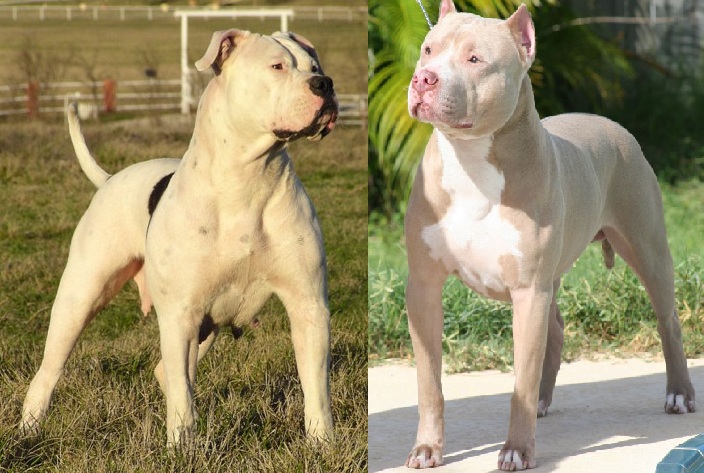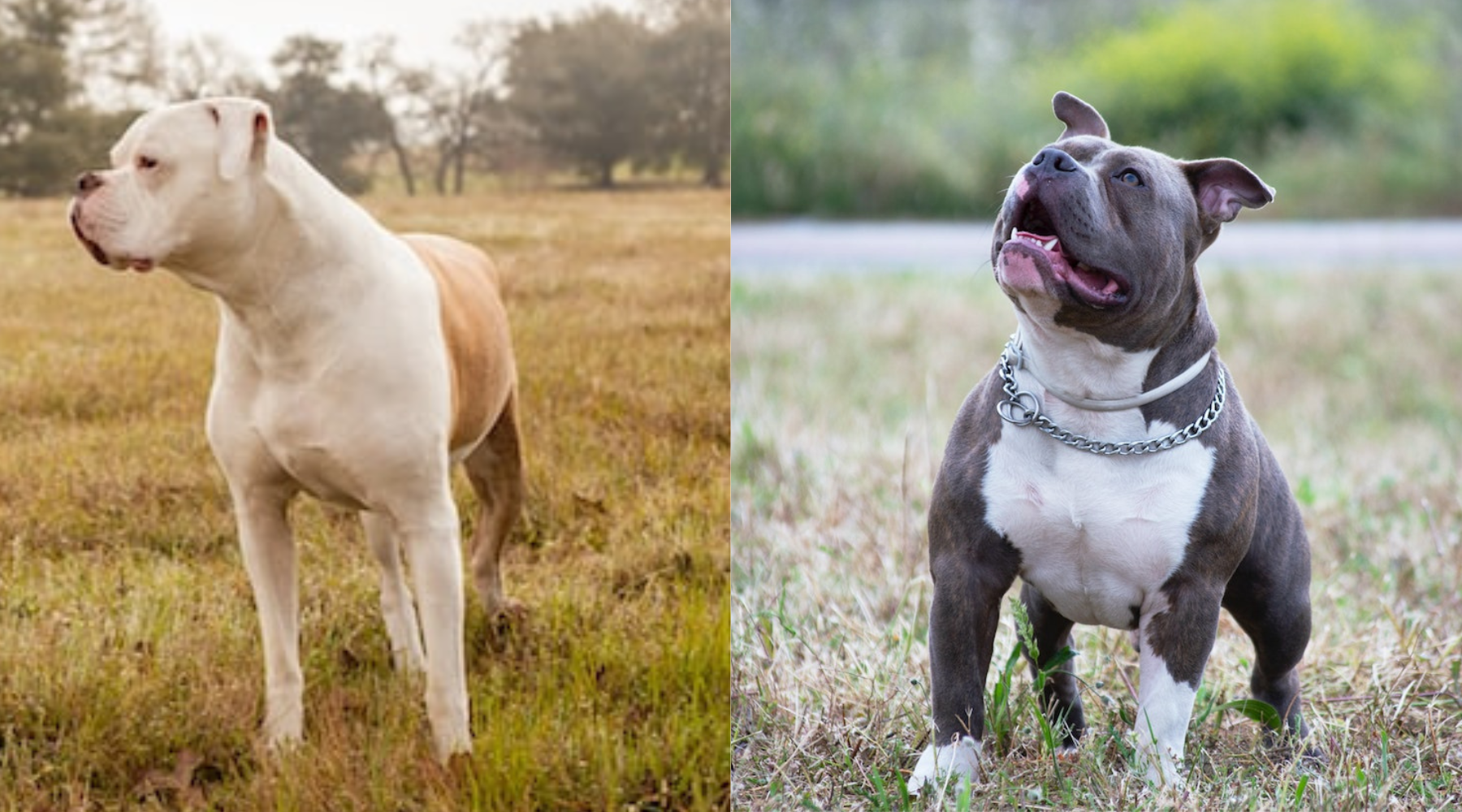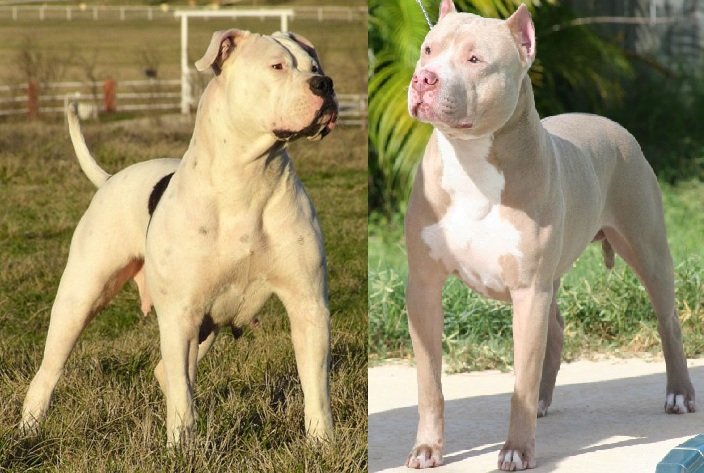Did you know that the bulldog and the pitbull are often mistaken for each other? Despite their similar appearance, they are actually two different breeds with distinct characteristics and origins.
The bulldog is a breed with a fascinating history. Originating in England, bulldogs were originally bred for bull-baiting, a brutal sport popular in the 17th century. However, after bull-baiting was banned in 1835, bulldogs were selectively bred for their friendly and gentle nature, making them the lovable companions we know today. On the other hand, the pitbull is not a specific breed but rather a term encompassing several breeds such as the American Pit Bull Terrier and the Staffordshire Bull Terrier. Pitbulls were originally bred for dog fighting, but like bulldogs, they too have become popular family pets when properly trained and socialized. Despite their differences, both breeds require responsible ownership and upbringing to ensure their well-being and prevent any negative stereotypes from perpetuating.
When it comes to the question “Is a Bulldog a Pitbull?” the answer is no. While both breeds fall under the category of “bully breeds,” they are distinct breeds with their own characteristics. Bulldogs are known for their stocky build and wrinkled face, while Pitbulls have a more muscular physique. Each breed also has its own temperament and exercise needs. So, while both breeds share some similarities, they are not the same.

Is Bulldog a Pitbull?
When it comes to dog breeds, there is often confusion and misinformation circulating among enthusiasts and pet owners. One common question that often arises is whether a bulldog is a pitbull. In this article, we will delve into the characteristics, history, and differences between these two breeds to provide clarity and dispel any misconceptions. If you’ve ever wondered about the distinctions between bulldogs and pitbulls, read on to find out the truth.
The Bulldog: History and Characteristics
The bulldog is a breed with a rich history that dates back to 13th century England. Originally bred for bull-baiting, these dogs were known for their strength and tenacity. Over the years, the bulldog has evolved into a loving and affectionate companion. Bulldogs are known for their distinctive pushed-in faces, muscular bodies, and loose, wrinkled skin. They have a friendly and gentle disposition, making them excellent family pets.
Bulldogs have a unique appearance that sets them apart from other breeds. Their short, smooth coats come in various colors, including brindle, fawn, and white. They have a stocky build, with a wide head, broad shoulders, and a compact frame. Despite their heavy appearance, bulldogs are surprisingly agile and need regular exercise to stay healthy and happy.
In terms of temperament, bulldogs are generally loyal, affectionate, and easygoing. They get along well with children and other pets, making them a popular choice for families. While they can be stubborn at times, they are known to be eager to please their owners and respond well to positive reinforcement training methods.
The Pitbull: History and Characteristics
Contrary to popular belief, the term “pitbull” does not refer to a specific breed but rather a group of breeds that share similar physical traits and ancestry. The American Pit Bull Terrier, American Staffordshire Terrier, and Staffordshire Bull Terrier are some of the breeds commonly associated with the term “pitbull.” These dogs have a controversial reputation due to their connection with dogfighting, but it is important to note that responsible ownership and proper training are key factors in a dog’s behavior.
Pitbulls are medium-sized dogs with strong, muscular bodies. They have short, dense coats that come in a variety of colors, including brindle, black, and blue. Their heads are broad and proportionate to their bodies, with a strong jaw and well-defined cheek muscles. Pitbulls are agile, energetic, and require regular exercise to maintain their physical and mental well-being.
In terms of temperament, well-socialized and properly trained pitbulls can be loving, affectionate, and loyal companions. They are known for their intelligence and eagerness to please their owners. However, due to their history of being bred for dogfighting, pitbulls may have a higher prey drive and may require extra attention and training to ensure they are well-behaved and socialized around other animals.
Physical Differences Between Bulldogs and Pitbulls
While both bulldogs and pitbulls have certain physical similarities, such as muscular builds and short coats, there are noticeable differences between the two breeds. Bulldogs have a distinct pushed-in face with a prominent underbite and a wide, wrinkled forehead. On the other hand, pitbulls have a more proportionate face with a strong jaw and well-defined cheek muscles.
In terms of size, bulldogs are generally smaller and more compact compared to pitbulls. Bulldogs typically weigh between 40-50 pounds, while pitbulls can range from 30-70 pounds depending on the specific breed. Additionally, pitbulls tend to be taller and have a more athletic build compared to the stockier appearance of bulldogs.
Another notable difference is the shape of their ears. Bulldogs often have rose-shaped ears that fold over at the side of their heads, while pitbulls have semi-prick or floppy ears that drop down and frame their faces. These variations contribute to the unique and distinct appearances of each breed.
Common Misconceptions about Bulldogs and Pitbulls
There are several misconceptions surrounding both bulldogs and pitbulls that have led to confusion and unfair stereotypes. One common misconception is that bulldogs are aggressive and prone to biting. In reality, bulldogs have been bred for generations to have a calm and gentle temperament, and aggression is not typically a characteristic of the breed.
Similarly, pitbulls are often portrayed as inherently aggressive and dangerous dogs. While it is true that pitbulls have been involved in unfortunate incidents, it is important to remember that a dog’s behavior is largely influenced by the way they are raised and trained. With responsible ownership and proper socialization, pitbulls can be loving and well-behaved companions.
It is crucial not to judge a dog based on their breed alone. Each dog is an individual with their own unique personality, and generalizing characteristics based on breed can lead to unfair assumptions and discrimination. It is essential to evaluate a dog’s temperament on a case-by-case basis and consider factors such as upbringing, socialization, and training.
Bulldogs and Pitbulls: Wonderful Companion Dogs
While there are distinct differences between bulldogs and pitbulls, both breeds can make wonderful companion dogs in the right environment. Bulldogs are known for their gentle and affectionate nature, making them perfect for families seeking a loyal, low-energy pet. Pitbulls, on the other hand, thrive in active households where they can receive ample exercise and mental stimulation.
Regardless of the breed you choose, responsible ownership, proper training, and socialization are crucial for raising a happy and well-rounded dog. Both bulldogs and pitbulls require love, attention, and commitment to thrive as part of a loving family. By providing a safe and nurturing environment, you can ensure that your bulldog or pitbull becomes a beloved companion for years to come.
Key Takeaways: Is Bulldog a Pitbull?
- Both bulldogs and pitbulls are different dog breeds.
- Bulldogs have a stocky build and a wrinkled face.
- Pitbulls are muscular dogs with a strong jaw.
- Bulldogs are known for their friendly and calm nature.
- Pitbulls can be energetic and protective.
Frequently Asked Questions
Welcome to our FAQ section where we answer some common questions related to the topic “is bulldog a pitbull?”. Read on to clear up any confusion you may have!
1. What are the differences between a bulldog and a pitbull?
While both bulldogs and pitbulls are popular and beloved dog breeds, they have notable differences. Bulldogs, known for their distinctive pushed-in faces and stocky build, are a breed of their own. On the other hand, pitbull is not a specific breed, but rather an umbrella term that includes a few different breeds such as the American Pit Bull Terrier, the American Staffordshire Terrier, and the Staffordshire Bull Terrier. Pitbulls tend to have a more muscular and lean build compared to bulldogs.
Additionally, bulldogs are known for their calm and gentle demeanor, while pitbulls can be more energetic and require regular exercise and mental stimulation. It’s important to note that individual dogs within these breeds may have different temperaments and behaviors.
2. Can a bulldog be considered a pitbull?
No, a bulldog cannot be considered a pitbull as they are two distinct breeds. Bulldogs, such as the English Bulldog or the French Bulldog, have their own breed standards and characteristics. Pitbull, as mentioned earlier, is an umbrella term encompassing certain breeds, and bulldogs are not included in this category.
It’s important to properly identify dog breeds as it helps with understanding their specific needs, temperament, and health requirements. If you are unsure about the type of your dog, consulting with a veterinarian or a professional dog breeder can help provide clarity.
3. Are bulldogs and pitbulls good family pets?
Yes, both bulldogs and pitbulls can make great family pets, but it depends on various factors. Bulldogs are often known for their gentle and affectionate nature, making them a popular choice for families. They are generally good with children and can be quite easygoing. However, they may require patience when it comes to training as they can be a bit stubborn at times.
Pitbulls, on the other hand, can also be wonderful family pets when properly trained and socialized from a young age. They are known for their loyalty and protective nature towards their families. However, it’s important to note that pitbulls may have specific breed restrictions or regulations in certain areas due to misconceptions and stereotypes surrounding the breed.
4. What should I consider before getting a bulldog or a pitbull?
Before getting any dog, including a bulldog or a pitbull, it’s crucial to consider several factors. First and foremost, consider your lifestyle and how much time and effort you can dedicate to caring for a dog. Bulldogs, for example, may have specific health concerns such as breathing difficulties due to their pushed-in faces, so you’ll need to be prepared for potential medical expenses or special care.
Another important aspect to consider is your living situation. Some housing options, such as apartments or rental properties, may have restrictions on certain dog breeds, including pitbulls. It’s essential to check local regulations to ensure that you can legally and safely house the dog breed you desire.
5. Can a bulldog and a pitbull be mixed?
Yes, it is possible for a bulldog and a pitbull to be mixed, creating a hybrid dog known as a “Bullypit” or an “American Bulldog Pitbull Mix.” These mixed breeds may exhibit a combination of physical and behavioral traits from both the bulldog and the pitbull. As with any mixed breed, the characteristics can vary from one individual to another, even within the same litter.
If you are considering adopting a mixed breed dog like a Bullypit, it’s essential to do your research and understand the potential traits and needs of both parent breeds. Additionally, make sure to interact with the puppy or dog before adoption to ensure it aligns with your lifestyle and preferences.

Bulldog VS Pitbull- Which Breed is Best For You?
Summary
So, to sum it all up, bulldogs and pitbulls are actually two different breeds. They may share some physical characteristics, but they have distinct genetic backgrounds.
Bulldogs are known for their wrinkled faces and stocky build, while pitbulls have a more muscular frame. Remember, it’s important to research and understand the specific traits of each breed before getting a pet, to ensure compatibility and responsible ownership.
